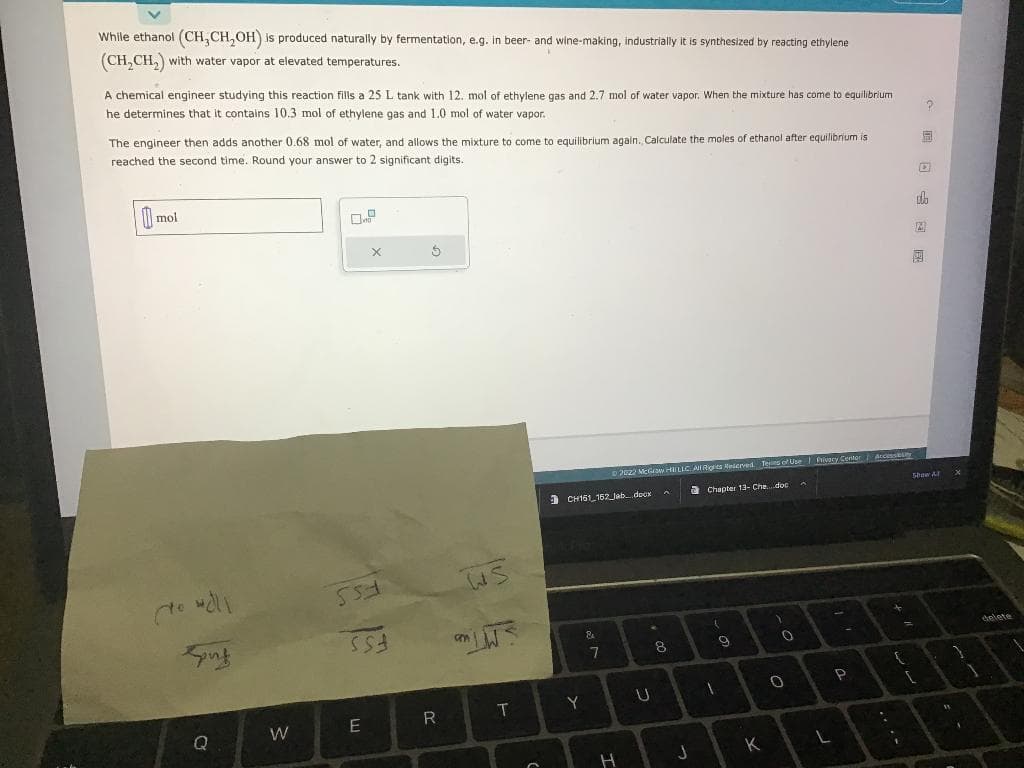While ethanol (CH₂CH₂OH) is produced naturally by fermentation, e.g. in beer- and wine-making, industrially it is synthesized by reacting ethylene (CH₂CH₂) with water vapor at elevated temperatures. A chemical engineer studying this reaction fills a 25 L tank with 12. mol of ethylene gas and 2.7 mol of water vapor. When the mixture has come to equilibrium he determines that it contains 10.3 mol of ethylene gas and 1.0 mol of water vapor. The engineer then adds another 0.68 mol of water, and allows the mixture to come to equilibrium again. Calculate the moles of ethanol after equilibrium is reached the second time. Round your answer to 2 significant digits. mol X O th
While ethanol (CH₂CH₂OH) is produced naturally by fermentation, e.g. in beer- and wine-making, industrially it is synthesized by reacting ethylene (CH₂CH₂) with water vapor at elevated temperatures. A chemical engineer studying this reaction fills a 25 L tank with 12. mol of ethylene gas and 2.7 mol of water vapor. When the mixture has come to equilibrium he determines that it contains 10.3 mol of ethylene gas and 1.0 mol of water vapor. The engineer then adds another 0.68 mol of water, and allows the mixture to come to equilibrium again. Calculate the moles of ethanol after equilibrium is reached the second time. Round your answer to 2 significant digits. mol X O th
Chemistry: The Molecular Science
5th Edition
ISBN:9781285199047
Author:John W. Moore, Conrad L. Stanitski
Publisher:John W. Moore, Conrad L. Stanitski
Chapter12: Chemical Equilibrium
Section: Chapter Questions
Problem 61QRT
Related questions
Question

Transcribed Image Text:While ethanol (CH3CH₂OH) is produced naturally by fermentation, e.g. in beer- and wine-making, industrially it is synthesized by reacting ethylene
(CH₂CH₂) with water vapor at elevated temperatures.
A chemical engineer studying this reaction fills a 25 L tank with 12. mol of ethylene gas and 2.7 mol of water vapor. When the mixture has come to equilibrium
he determines that it contains 10.3 mol of ethylene gas and 1.0 mol of water vapor.
The engineer then adds another 0.68 mol of water, and allows the mixture to come to equilibrium again. Calculate the moles of ethanol after equilibrium is
reached the second time. Round your answer to 2 significant digits.
mol
to will
Q
W
x
551
SSA
E
$
R
WS
IW
an
T
6
© 2022 McGraw HILLC. All Rights Reserved. Terms of Use | Privacy Center Accessity
Chapter 13- Che...doc
CH151 152 Jab .docx
Y
&
7
H
U
8
J
(
9
1
K
1
0
0
A
L
P
+
{
A
8
@
db
Show Al
[
11
1
1
delete
Expert Solution
This question has been solved!
Explore an expertly crafted, step-by-step solution for a thorough understanding of key concepts.
This is a popular solution!
Trending now
This is a popular solution!
Step by step
Solved in 2 steps with 2 images

Knowledge Booster
Learn more about
Need a deep-dive on the concept behind this application? Look no further. Learn more about this topic, chemistry and related others by exploring similar questions and additional content below.Recommended textbooks for you

Chemistry: The Molecular Science
Chemistry
ISBN:
9781285199047
Author:
John W. Moore, Conrad L. Stanitski
Publisher:
Cengage Learning

Chemistry & Chemical Reactivity
Chemistry
ISBN:
9781337399074
Author:
John C. Kotz, Paul M. Treichel, John Townsend, David Treichel
Publisher:
Cengage Learning

Introductory Chemistry: A Foundation
Chemistry
ISBN:
9781285199030
Author:
Steven S. Zumdahl, Donald J. DeCoste
Publisher:
Cengage Learning

Chemistry: The Molecular Science
Chemistry
ISBN:
9781285199047
Author:
John W. Moore, Conrad L. Stanitski
Publisher:
Cengage Learning

Chemistry & Chemical Reactivity
Chemistry
ISBN:
9781337399074
Author:
John C. Kotz, Paul M. Treichel, John Townsend, David Treichel
Publisher:
Cengage Learning

Introductory Chemistry: A Foundation
Chemistry
ISBN:
9781285199030
Author:
Steven S. Zumdahl, Donald J. DeCoste
Publisher:
Cengage Learning

Chemistry
Chemistry
ISBN:
9781305957404
Author:
Steven S. Zumdahl, Susan A. Zumdahl, Donald J. DeCoste
Publisher:
Cengage Learning


Chemistry: An Atoms First Approach
Chemistry
ISBN:
9781305079243
Author:
Steven S. Zumdahl, Susan A. Zumdahl
Publisher:
Cengage Learning